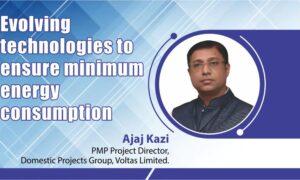Business process happen when people see opportunity.
How technology will drive the cold chain post Covid It is not only technology, it must be innovation. It has participation, it must be action by government and private sector and many more things than that. So what drives the cold chain? Refrigeration preserves nourishment, adds value to agriculture, and extends healthcare services for humanity. The practice of refrigeration has historically provided an essential service for communities across the diverse fabric of India, and will increasingly continue to enhance the lives of many. So this was the quote on World Refrigeration day. I am just talking about many of the components which are engaged and which must be integrated for the cold chain. Large warehouses like this, which may be fully refrigerated or partly refrigerated, are coming up across our country. And they are managed either by an end to end company or they are owned by somebody who provides the services of the warehouse as well as the transport. And there are large ones coming up all over India. And in Mumbai, Bhiwandi, there are a very large number of them, Amazon has put up one, there’s a large investor from all the way from Raipur investing in a large warehouse in Mumbai. To integrate the cold chain transit of warehouse’s goods seamlessly to the delivery point, is effected in a very sequential kind of way. And that can be a commercial cold display or can be a supermarket. In Hyderabad, a new food and fruit market at a place I know is a very simple one and hundreds of people come every day in and out. I spoke to the people who run this and came to know that the food is coming from very far away places. Last year, the government of India railway started end-to-end delivery for very long distance like cold chain logistics carrying refrigerated cargo like this. In the shortest span of time, and also the cheapest way of transport, rail corridors have opened for the delivery of replicated products. So, you can have apples from Himachal coming all the way down to Trivandrum and something from Trivandrum, maybe coconuts, going all the way to Kashmir. So here is another thing: the Konkan railway has started this roll on roll off trucks. Here is a case of roll on roll off trucks. These are ordinary trucks, but you could equally have them refrigerated, what about aggregating the 1000s and the 100s of 1000s of truck operators all across India, and many of them have converted to reefer trucks. And you can have an app to connect the reefer truck owners and the fleet with buyers. And so it will be a short and a good service and everything can be tracked. All the money can be traced the moment it can be traced. You’ve all seen containers like this with containers. They’ve been around for a long time. But managing well getting them back quickly. Integrating the way we load and unload all these things has to happen seamlessly. And of course this is the more recent version of these cold chain materials. It doesn’t require continuous refrigeration; it stores energy in the form of base chain materials. Now they want up to eight hours of storage and I’m told by a manufacturer in Mumbai that we can give up to -40 deg temperature also, which is wonderful. And of course it is extended to last mile deliveries through boxes of the same kind of material. And there are going to be big digital tools and software to manage the cold chain.
So you’re guaranteed the product, quality, time and everything else that is happening in between. The temperatures can be logged and you can see it directly on your screen and the billing can be managed. So software is going to be a big integrator.
Aggregating farm produce for extended reach and cost realisation
So there are cooperative farms now especially in Maharashtra, where the aggregate farmers produce into back houses are sorted and packed. And there’s warehousing thereafter, the dispatching, retailing; they even manage their own stores, they can supply to anybody else. They exported mangoes to England, using the help of Hindustan Aeronautics for container management. And so this cooperative farm, which is managed by a smart engineer, whom we met has got 800 farmers to earn 30 crores, in one year, to say an average of 3.75 lakhs per farmer. Obviously, some farmers got much more, and some got somewhat less.
Skill development centres
Agriculture is India’s largest food production apart from meats and poultry and many other things like that. So we have the second largest agricultural land in the world, the United States. Our exports of food, farm agriculture are the highest, or maybe the second highest, but the realisation of profit is the lowest, maybe because a lot of it goes free because of access. So we must learn to make the farmers become like this, they must be able to aggregate themselves, they have to be skilled, someone must invest in them, there must be a business model to do it.
Now we are moving on to frozen foods and blast freezing, which extends the life of foods that don’t damage them. And that’s all the practice but it’s got far more technically improved now about different types of foods, and how you package them and now automation has come into it. So many products have touched $6.7 billion. India produces more than 500,000 tonnes of pork, which is a very popular meat in Punjab in the south of India many other places, but we don’t export enough of it. So there’s a big opportunity over there because this product is much relished in Southeast Asia. And so the goat, I’m from Hyderabad, Telangana you find probably 10 times more good than people. But I also have the biggest export of goat meat from there. We currently export a lot to Africa, the Middle East, and so on and so forth. But it is just 6.4% of the production.
That means all the goats are eaten up in India or somewhere else. So there’s a big opportunity for furthering exports.
Technology opportunities
Somebody must be different in a business case, somebody must package the meat into more presentable products. And you know, the goat has many parts of it, which are relished by people who know about goat meat. So what about successful reefer transport?
India exported buffalo meat, we are the largest exporter of buffalo meat in the world, much higher than Australia, and probably Buffalo and beef for the same thing. Finally, even in the pandemic, there was a decrease, but we still were the largest. So that’s the whole thing. And so obviously, this is a big business opportunity, and further packaging and diversification can get far more demand. The demand for horticulture, dairy, livestock and fish is growing faster than food grains like pulses, cereals, wheat, and rice and so on. They are increasing, but the actual rate of growth isn’t meat, fish, eggs, fruits, processed vegetables and milk. So, what does this mean for us? It means that refrigeration is very much required and that has to be properly channelised.
Pushing the modern pack out
The government of India is really pushing hard for 1000s of back houses to open so what does it say when you catch the harvest. So there’s a multilayered way of processing food using the modern pack house. So this is where the technology has to come in. This is where the management has to come in. This is where larger investors have to see opportunities. So business processes happen when people see opportunity.
In conclusion, the cold chain connects value, extends market reach and is all about inventory in motion. Such a wonderful term, I think it’s a combination bond to deliver more over longer distances. And then power producers have a multiplier effect and an early social economic growth. And it’s all about the economics of the whole system to get the farmer far better realised value for this product. It is really inherently the backbone for agriculture.
And of course, it offers a logical, sustainable, and everything must be in that manner to allow human time to continue to progress. When you can reach further away, the more money you can get. That’s the whole secret to anything, you can go onto those drugs and go from Pondicherry to Patiala.
And you can get more money because they will get food there which they don’t get at their place. So this is the whole thing. And otherwise, if it’s a short term, there are a lot because of the surplus. And the other thing is because of lack of delivery, there’s a big shortfall in supply.
I say that technology must have the cold chain, the process and protocols must drive the cold chain rather than just the price.
Cookie Consent
We use cookies to personalize your experience. By continuing to visit this website you agree to our Terms & Conditions, Privacy Policy and Cookie Policy.















